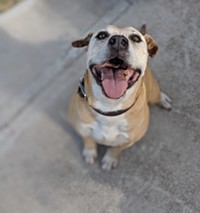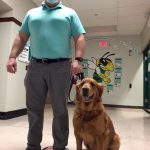Helping Dogs On The Loose
June 25, 2020

What options are available to you if you find a stray dog? In most places in the U.S., you have four options: 1. Drop the dog off at the municipal shelter. 2. Call animal control and have them pick up the dog. 3. Hold on to the dog and try to find the owner yourself. 4. Ignore the dog and let it go.
These options are all problematic. Options 1 and 2 require taking the dog out of their community and transporting it to an offsite location, sometimes many miles from its home. Once the dog leaves its community, it can be difficult to get it home. Reclaim fees, long distance to the shelter, fear of animal services and many other factors contribute to people not reclaiming their dogs. The shelters that have the most sophisticated and successful return programs have gotten up to 45 percent of impounded dogs home, but for most shelters, that number is still very low, around 15 or 20 percent. Option 3 puts the entire burden of getting the dog home on the finder, who may not know about all of the available resources or have the time to make found posters and post found information online. Option 4 isn’t feasible or ideal when a dog is in distress, is truly lost, is injured or sick, or otherwise really needs the help of a Good Samaritan.
So what should animal services agencies do to help? One of the most important functions of animal services is to help stray and lost dogs. Have you ever seen a lost dog running down the side of a busy, multi-lane road, panting and anxiously looking for safety? Our animal protection officers help save dogs that have found themselves lost and afraid and often injured, on an almost-daily basis. Our shelter serves as a very short-term crisis housing center for dogs in distress who get picked up by a community member or an officer. However, at the same time, we recognize that many stray dogs are hanging out in their neighborhoods, just a house or two away from where they live, and we may be able to get those dogs home more easily if we don’t remove them from their communities. Over the past two decades, animal welfare has come so far when it comes to innovation and we’re long overdue for rethinking our approach to stray dogs. Here are some starting points:
Create and implement a stray dog intake needs assessment. Imagine you find a stray dog. It appears healthy and is wagging its tail. You find your local shelter’s website and read that you can call or text the shelter and file a found report. You text the shelter and someone texts you right back. They ask you several questions, including where the dog was found; if it has any injuries or appears to be sick; if the dog is friendly; if it has identification; if the finder is willing to hold the dog for up to 72 hours to help us try to get it home. If the dog is sick or injured, poses any threat to public safety, is not safe to handle, or is in immediate danger and the finder cannot hold it, then the best place for that dog is likely the shelter. If the dog is healthy and friendly and the finder is willing to hold it for a short time, that’s where the animal services organization can really kick into action!
Get that dog home! If you’re is willing to hold on to a found dog, you can do a number of things to help that dog get home faster. First, create a found report and get it online right away. Second, staff or volunteers can post the dog’s information on social media sites like Facebook lost and found pages and Craigslist. You can e-mail the finder a printable FOUND sign or print signs yourself and ask volunteers to post them in the area. Share a ‘getting lost pets home’ tips sheet or e-mail with finders and ask them to go to the nearest participating veterinarian or other business who will scan the dog for a microchip. Just because someone is willing to hold the dog, doesn’t mean there aren’t lots of things staff and volunteers can do to help them. Can you imagine how fast you could get dogs home if you provided all this help to stray finders and provide excellent, prompt service to locate owners?
Ask for help but don’t create a black-and-white policy.We are here to serve the public and there really are stray dogs who need to come to the shelter. If your goal is to intake the dogs who really need to come in while helping dogs get home and stay in the community any time it’s possible, you will need to use a case management approach, explain to the community WHY you’re trying to reduce the number of stray dogs who enter the shelter, and earnestly as for help. There will always be some people who just won’t want to hold a stray dog they’ve found and so we need to think about how to help those dogs too. Can you create a stray found-to-foster program in your high intake neighborhoods? Can you engage other people in the area to hold those strays? What if you found a few animal lovers in your high intake neighborhoods and pay them to be the first point of contact to hold stray dogs so they can be more easily returned? You could even give these people spay/neuter, vaccine and microchip vouchers to give to the owners once the dog is returned. Most communities aren’t yet trying these strategies, but they should be.
Communicate constantly with your community.Tell them how many stray dogs are coming in to the shelter and why bringing a dog to the shelter isn’t always the best solution. Tell them how they can help by holding a stray dog and what services you offer to get those dogs home. Track your data to learn what the return rate is of dogs who do NOT come to the shelter, but stay in a home instead. It’s likely to be much higher and you can use this to explain why you are asking for their help. Talk to people about the importance of securing their fences and offer fence building and fence repair assistance to help prevent dogs from getting loose. Tell the stories of injured and sick stray dogs who you helped and also tell stories of the local heroes who found a dog, held it, and helped to get it home. Talk about how you’re working to address the root causes that lead to dogs getting out of their homes and yards. Tell people how they can help. We’ve spend more than 100 years telling people to bring every stray dog to the shelter. Now we have to do the work of asking our communities to be part of the solution to keep and get dogs home.
As we build a whole, new range of services to help keep dogs in their homes and communities and reduce the number of stray and lost dogs entering the shelter, we should also use the tools and resources available to help get as many dogs as possible identified. Animal services should provide both microchips and tags on a voluntary basis because proactive identification is the best option we have to reducing shelter intake and making sure we get dogs back with their owners.


 When Luke Hengen’s diabetes worsened in his early twenties, it stripped him of the outdoor activities where the country kid felt at home. Countless wilderness adventures and years of hard-fought football games took a toll on his body, to the point where he could no longer sense when his blood sugar was too high or […]
When Luke Hengen’s diabetes worsened in his early twenties, it stripped him of the outdoor activities where the country kid felt at home. Countless wilderness adventures and years of hard-fought football games took a toll on his body, to the point where he could no longer sense when his blood sugar was too high or […] When middle school students return to class on Jan. 11, they’ll find a new face at the door: Daisy. Daisy is a therapy dog and the personal pet of Rob Kreger, principal of the Rock L. Butler Middle School. The five-year-old golden retriever is not a school pet or mascot, but rather a working dog […]
When middle school students return to class on Jan. 11, they’ll find a new face at the door: Daisy. Daisy is a therapy dog and the personal pet of Rob Kreger, principal of the Rock L. Butler Middle School. The five-year-old golden retriever is not a school pet or mascot, but rather a working dog […] Last March, Caroline Benzel, a third-year medical student, began to notice the stress and discomfort her nurse friends were feeling from the pressures of the ongoing Covid-19 pandemic. “[Personal protective equipment] can be really rough on the skin,” Benzel, 31, tells PEOPLE. Benzel and her 3-year-old Rottweiler, Loki (who’s also a therapy dog) hatched a […]
Last March, Caroline Benzel, a third-year medical student, began to notice the stress and discomfort her nurse friends were feeling from the pressures of the ongoing Covid-19 pandemic. “[Personal protective equipment] can be really rough on the skin,” Benzel, 31, tells PEOPLE. Benzel and her 3-year-old Rottweiler, Loki (who’s also a therapy dog) hatched a […] When Stanley the miniature fox terrier’s owner passed away, the little dog started a ‘paw-some’ new role – bringing puppy love to some of the Gold Coast’s oldest residents. After Carinity Cedarbrook Diversional Therapist Julianne Staff adopted Stanley, he began visiting the aged care community at Mudgeeraba as a therapy dog. Therapy dogs help to […]
When Stanley the miniature fox terrier’s owner passed away, the little dog started a ‘paw-some’ new role – bringing puppy love to some of the Gold Coast’s oldest residents. After Carinity Cedarbrook Diversional Therapist Julianne Staff adopted Stanley, he began visiting the aged care community at Mudgeeraba as a therapy dog. Therapy dogs help to […] A nonprofit is providing an unusual form of therapy for those on the front lines of the coronavirus pandemic – puppy cams! “You spend five minutes with a puppy and try not to smile,” said registered nurse Robin Lingg Lagrone. Lingg Lagrone says watching little furballs wag their tails and prance on their paws helps […]
A nonprofit is providing an unusual form of therapy for those on the front lines of the coronavirus pandemic – puppy cams! “You spend five minutes with a puppy and try not to smile,” said registered nurse Robin Lingg Lagrone. Lingg Lagrone says watching little furballs wag their tails and prance on their paws helps […] When Moore County’s school doors were abruptly closed earlier in 2020, two- and four-legged volunteers from the Moore County Citizens’ Pet Responsibility Committee (PRC) were in their 12th year of presenting a six-session Pet Responsibility Education Program for fourth-graders. The PRC quickly shifted gears and placed its program materials online as part of a home […]
When Moore County’s school doors were abruptly closed earlier in 2020, two- and four-legged volunteers from the Moore County Citizens’ Pet Responsibility Committee (PRC) were in their 12th year of presenting a six-session Pet Responsibility Education Program for fourth-graders. The PRC quickly shifted gears and placed its program materials online as part of a home […]